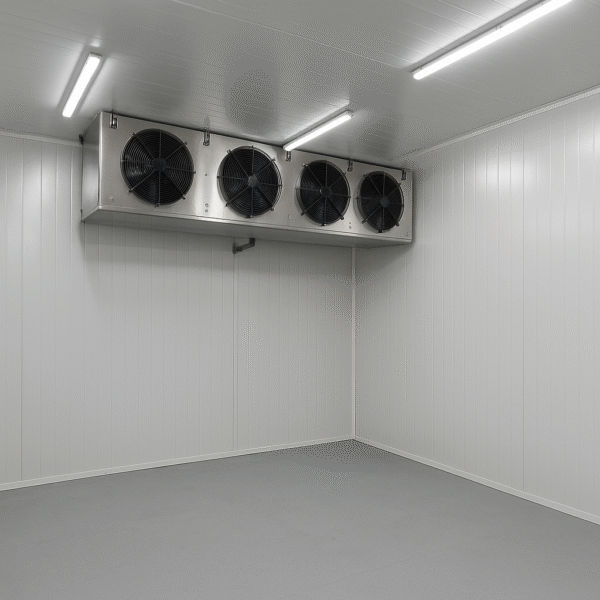What Determines Cold Room Installation Costs?

❄️ What Determines Cold Room ? Installation Costs?
Cold rooms are essential for food, pharmaceutical, logistics, and various industrial sectors. However, one of the most common questions businesses ask is: “How much does it cost to install a cold room?” The answer is not straightforward—costs vary depending on several factors. Here's a breakdown of what influences cold room installation prices:
📏1. Size and Volume of Room System ?
The internal volume of the cold room (in cubic meters) directly affects the price. Larger rooms require more insulation panels, stronger cooling units, and more labor.
Small-scale rooms: 5–20 m³
Medium-scale rooms: 20–50 m³
Large storage rooms: 50+ m³
👉 The bigger the volume, the higher the cost.
❄️ 2. Cooling Type: Positive, Negative, Deep-Freezing or Blast Freezing?
Positive Cold Room: Typically +2°C to +8°C, suitable for storing fruits, vegetables, dairy products, beverages, and other fresh goods.
Negative Cold Room: Generally maintained at -18°C, ideal for frozen meat, poultry, seafood, and long-term storage.
Deep Freezing Rooms: Can reach down to -25°C, used for products that require deeper and more stable freezing conditions.
Blast Freezer (Shock Freezing) Rooms: Go as low as -40°C, designed for rapid freezing of products like meat, fish, or ready-to-eat meals to preserve quality and shelf life.
❗ Negative, deep-freezing, and blast freezing rooms are more expensive due to the need for stronger insulation, more powerful compressors, and higher energy efficiency components.
🧱 3. Panel Thickness, Insulation Quality & Material Standards
Panel thickness is a key factor in both thermal insulation and installation cost. The required thickness depends directly on the internal temperature of the cold room.
📊 Recommended Panel Thickness by Temperature:
| Internal Temperature | Recommended Panel Thickness |
|---|---|
| +5°C and above | 6 cm – 8 cm |
| +5°C to –5°C | 8 cm |
| –5°C to –18°C | 10 cm – 12 cm |
| –18°C to –25°C | 12 cm – 15 cm |
| Shock Freezer (–40°C) | 15 cm – 20 cm |
Thicker panels reduce thermal losses and are critical in negative and ultra-low temperature rooms such as deep-freezing and blast freezing chambers.
🧪 Polyurethane Foam Density: Why It Matters
The density of polyurethane insulation used inside the panel directly affects cooling performance and energy efficiency.
The optimal PU foam density is between 38–42 kg/m³.
At Esad Panel, we strictly do not recommend using panels with a density lower than 38 kg/m³ for cold room applications, as they compromise insulation and lead to higher energy consumption.
🛡️ Steel Sheet Thickness & External Durability
The thickness of the metal sheet used on the surface of the insulation panels is equally important for durability against physical and environmental impacts.
Minimum acceptable thickness: 0.35 mm
Standard option: 0.40 mm
Ideal choice for long-term use: 0.50 mm
Thicker sheets improve the panel’s resistance to dents, corrosion, and external wear, especially in commercial or industrial environments.
🧼 Corrosion Resistance & Hygiene Standards
When buying insulated panels, it is also crucial to evaluate the hygienic and anti-corrosive properties of the metal surface.
Panels should be coated with materials that are rust-resistant and antibacterial.
This is particularly important in industries such as food storage, meat processing, or pharmaceuticals, where hygiene regulations are strict.
👉 While these features may slightly increase the initial cost, they offer significant benefits in terms of safety, longevity, and compliance.
🚪 4. Door Type?
The type of cold room door significantly impacts both usability and cost:
Hinged door (standard)
Sliding door (more expensive, for large-scale operations)
Glass observation doors (used in retail or special conditions)
🔧5.Optional Add-ons and Accessories
Optional components that can increase the cost include:
Shelving systems
Temperature monitoring and control systems
Remote alarm and SMS alert systems
Humidity control units
These upgrades add professionalism and functionality but come at an additional cost.
🛠️ 6. Compressor Brands and Performance Differences
The compressor is the heart of your cold room, and its quality strongly influences both pricing and long-term reliability.
✅ Mid-Range Compressor Brands
Brands like Dorin, Tecumseh, and Frascold offer balanced performance and price. These are ideal for small to medium-sized cold rooms and are widely available in most markets.
 Bitzer (Germany): Premium Quality
Bitzer (Germany): Premium Quality
Bitzer is considered the top-tier compressor brand globally. It offers:
Longest lifespan
Highest energy efficiency
Excellent long-term investment for heavy-duty and export-oriented facilities
Although Bitzer comes with a higher price tag, it pays off in reliability and reduced maintenance costs.
🔄 Hermetic vs Semi-Hermetic Compressors
Hermetic compressors are sealed, affordable, and used in compact systems. However, they cannot be repaired if damaged.
Semi-hermetic compressors are more expensive but repairable, and ideal for long-term commercial use.
Semi-hermetics can also include optional low-noise series, inverter drive, and advanced protection systems—features that add to the cost but greatly improve performance and energy efficiency.
📌 Final Thoughts: Always Go for a Custom Quote
Every cold room project is unique. Size, temperature needs, components, and location all shape the final cost.
📩 Share your project details with us, and we’ll prepare a personalized and competitive quote tailored to your business needs.




